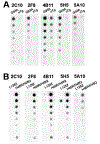Novel SOD1 monoclonal antibodies against the electrostatic loop preferentially detect misfolded SOD1 aggregates
- PMID: 33346076
- PMCID: PMC9171709
- DOI: 10.1016/j.neulet.2020.135553
Novel SOD1 monoclonal antibodies against the electrostatic loop preferentially detect misfolded SOD1 aggregates
Abstract
Amyotrophic lateral sclerosis (ALS) is a progressive neurological disease that leads to motor neuron degeneration and paralysis. Superoxide dismutase (SOD1) mutations are the second most common cause of familial ALS and are responsible for up to 20 % of familial ALS cases. In ALS patients, SOD1 can form toxic misfolded aggregates that deposit in the brain and spinal cord. To better detect SOD1 aggregates and expand the repertoire of conformational SOD1 antibodies, SOD1 monoclonal antibodies were generated by immunizing SOD1 knockout mice with an SOD1 fragment consisting of amino acids 129-146, which make up part of the electrostatic loop. A series of hybridomas secreting antibodies were screened and five different SOD1 monoclonal antibodies (2C10, 2F8, 4B11, 5H5, and 5A10) were found to preferentially detect denatured or aggregated SOD1 by enzyme-linked immunosorbent assay (ELISA), filter trap assay, and immunohistochemical analysis in SOD1 mouse models. The staining with these antibodies was compared to Campbell-Switzer argyrophilic reactivity of pathological inclusions. These new conformational selective SOD1 antibodies will be useful for clinical diagnosis of SOD1 ALS and potentially for passive immunotherapy.
Keywords: Amyotrophic lateral sclerosis; Antibodies; Frontotemporal dementia; Pathology; Silver stain; Superoxide dismutase 1.
Copyright © 2020 Elsevier B.V. All rights reserved.
Conflict of interest statement
Figures







Similar articles
-
Immunochemical characterization on pathological oligomers of mutant Cu/Zn-superoxide dismutase in amyotrophic lateral sclerosis.Mol Neurodegener. 2017 Jan 5;12(1):2. doi: 10.1186/s13024-016-0145-9. Mol Neurodegener. 2017. PMID: 28057013 Free PMC article.
-
Identification of a misfolded region in superoxide dismutase 1 that is exposed in amyotrophic lateral sclerosis.J Biol Chem. 2014 Oct 10;289(41):28527-38. doi: 10.1074/jbc.M114.581801. Epub 2014 Aug 27. J Biol Chem. 2014. PMID: 25164820 Free PMC article.
-
TNF receptor-associated factor 6 interacts with ALS-linked misfolded superoxide dismutase 1 and promotes aggregation.J Biol Chem. 2020 Mar 20;295(12):3808-3825. doi: 10.1074/jbc.RA119.011215. Epub 2020 Feb 6. J Biol Chem. 2020. PMID: 32029478 Free PMC article.
-
SOD1 in neurotoxicity and its controversial roles in SOD1 mutation-negative ALS.Adv Biol Regul. 2016 Jan;60:95-104. doi: 10.1016/j.jbior.2015.10.006. Epub 2015 Oct 31. Adv Biol Regul. 2016. PMID: 26563614 Review.
-
Does wild-type Cu/Zn-superoxide dismutase have pathogenic roles in amyotrophic lateral sclerosis?Transl Neurodegener. 2020 Aug 19;9(1):33. doi: 10.1186/s40035-020-00209-y. Transl Neurodegener. 2020. PMID: 32811540 Free PMC article. Review.
Cited by
-
Variation in the vulnerability of mice expressing human superoxide dismutase 1 to prion-like seeding: a study of the influence of primary amino acid sequence.Acta Neuropathol Commun. 2021 May 20;9(1):92. doi: 10.1186/s40478-021-01191-w. Acta Neuropathol Commun. 2021. PMID: 34016165 Free PMC article.
-
Structural Insights into the Dynamics of Water in SOD1 Catalysis and Drug Interactions.Int J Mol Sci. 2025 Apr 29;26(9):4228. doi: 10.3390/ijms26094228. Int J Mol Sci. 2025. PMID: 40362464 Free PMC article.
References
-
- Rosen DR, Siddique T, Patterson D, Figlewicz DA, Sapp P, Hentati A, Donaldson D, Goto J, O’Regan JP, Deng H-X, Rahmani Z, Krizus A, McKenna-Yasek D, Cayabyab A, Gaston SM, Berger R, Tanzi RE, Halperin JJ, Herzfeldt B, Van den Bergh R, Hung W-Y, Bird T, Deng G, Mulder DW, Smyth C, Laing NG, Soriano E, Pericak–Vance MA, Haines J, Rouleau GA, Gusella JS, Horvitz HR, Brown RH, Mutations in Cu/Zn superoxide dismutase gene are associated with familial amyotrophic lateral sclerosis, Nature 362 (1993) 59–62. 10.1038/362059a0. - DOI - PubMed
Publication types
MeSH terms
Substances
Grants and funding
LinkOut - more resources
Full Text Sources
Other Literature Sources
Molecular Biology Databases
Miscellaneous

